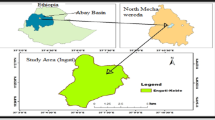Abstract
Food and fiber demand is increasing due to population growth, which compels us to optimize the irrigation system's performance to get more yield of food and fiber from the available resource. The high yielding varieties of crop requires a timely and adequate supply of water. A well-performing, well-managed irrigation system is a prerequisite to ensure a timely and proper water supply. The development of technology makes us ease in assessing the performance of the irrigation system. The availability of geospatial data in conjunction with the other ground data helps assess the performance minutely in spatial and temporal approaches. Performance evaluation of a canal irrigation system can be carried out by evaluating its actual water dynamics, water use, and productivity. Gadarjudda and Lakhnauta minor canal systems of the Upper Ganga Canal (UGC) are old systems and still performing in the right way with general maintenance works. The minor systems are decade old, and ungauged water management is carried out effectively. The physical condition of systems is not good; however, the canal carries the designed discharge. The results show that depleted fraction of Gadarjudda and Lakhnauta minor is nearly 1 to 1.30 kg/m3 for paddy productivity (actual water consumed), followed by Wheat and Sugarcane productivity by 1.61 kg/m3 and 6.08 kg/m3, respectively. The spatial maps of the indicator generated in the GIS environment give the information of the irrigation system's performance over command areas and help for evaluation. Thus, the study reveals the excellent performance of the UGC system.
Access this chapter
Tax calculation will be finalised at checkout
Purchases are for personal use only
Similar content being viewed by others
References
Ahmad MUD, Turral H, Nazeer A (2009) Diagnosing irrigation performance and water productivity through satellite remote sensing and secondary data in a large irrigation system of Pakistan. Agric Water Manag 96(4):551–564
Allen RG, Pereira LS, Raes D, Smith M (1998) Crop Evapotranspiration-Guidelines for computing crop water requirements-FAO Irrigation and drainage paper 56. FAO, Rome 300(9):D05109
Allen RG, Pereira LS, Smith M, Raes D, Wright JL (2005) FAO-56 dual crop coefficient method for estimating evaporation from soil and application extensions. J Irrig Drain Eng 131(1):2–13
Bastiaanssen WG (1998) Remote sensing in water resources management: the state of the art. International Water Management Institute, pp 1–118
Bos MG, Murray-Rust DH, Merrey DJ, Johnson HG, Snellen WB (1993) Methodologies for assessing performance of irrigation and drainage management. Irrig Drain Syst 7(4):231–261
Bos MG, Burton MA, Molden DJ (2005) Irrigation and drainage performance assessment: practical guidelines. Cabi Publishing, pp 26–46
Doorenbos J, Kassam AH (1979) Yield response to water. Irrigat Drainage Paper 33:257
Kumar R, Singh RD, Sharma KD (2005) Water resources of India. Curr Sci 89(5):794–811
Molden DJ, Sakthivadivel R, Perry CJ, De Fraiture C (1998) Indicators for comparing performance of irrigated agricultural systems. In: IWMI, vol 20, pp 1–26
Oweis TY, Hachum AY (2003) 11 Improving water productivity in the dry areas of West Asia and North Africa. Water Prod Agric: Limits Opportunities Improvement 1:179
Pandey A, Mogarekar N (2021) Development of a spatial decision system for irrigation management. J Ind Soc Remote Sens. https://doi.org/10.1007/s12524-020-01305-
Ray SS, Dadhwal VK, Navalgund RR (2002) Performance evaluation of an irrigation command area using remote sensing: a case study of Mahi command, Gujarat, India. Agric Water Manage 56(2):81–91
Zwart SJ, Bastiaanssen WG (2004) Review of measured crop water productivity values for irrigated wheat, Paddy, cotton and maize. Agric Water Manag 69(2):115–133
Author information
Authors and Affiliations
Editor information
Editors and Affiliations
Rights and permissions
Copyright information
© 2022 The Author(s), under exclusive license to Springer Nature Switzerland AG
About this chapter
Cite this chapter
Jha, R., Pandey, A., Ale, S. (2022). Performance Evaluation of a Minor of Upper Ganga Canal System Using Geospatial Technology and Secondary Data. In: Pandey, A., Chowdary, V.M., Behera, M.D., Singh, V.P. (eds) Geospatial Technologies for Land and Water Resources Management. Water Science and Technology Library, vol 103. Springer, Cham. https://doi.org/10.1007/978-3-030-90479-1_10
Download citation
DOI: https://doi.org/10.1007/978-3-030-90479-1_10
Published:
Publisher Name: Springer, Cham
Print ISBN: 978-3-030-90478-4
Online ISBN: 978-3-030-90479-1
eBook Packages: Earth and Environmental ScienceEarth and Environmental Science (R0)




